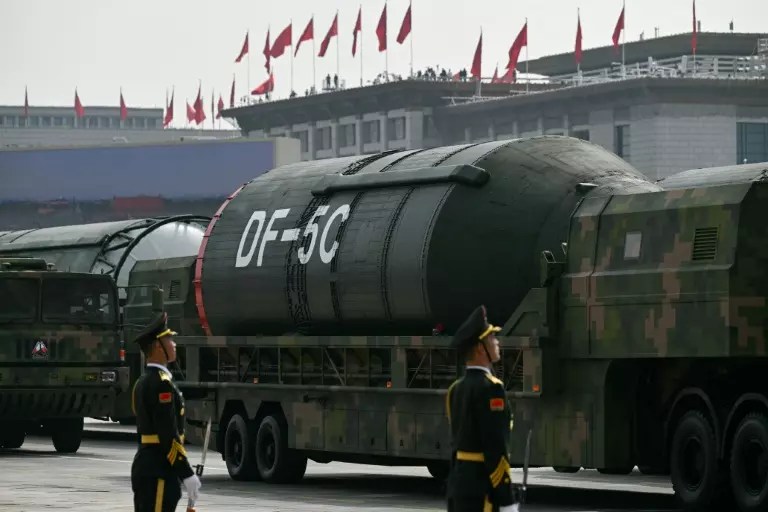A Dazzling Display of Military Might: China’s Major Parade
On a striking Wednesday in Beijing, a significant military parade captured both the awe and attention of the global audience. Underwater drones, colossal missiles, and advanced laser weapons showcased China’s military prowess amid ongoing tensions with Washington. This grand affair not only celebrated China’s achievements but also sent a bold message to the world, especially to its adversaries.
High-Profile Attendance
The event was graced by several prominent foreign leaders, including Russian President Vladimir Putin and North Korean leader Kim Jong Un. Their presence underscored the strategic alliances being forged in a time marked by geopolitical uncertainty. Military specialists keenly observed the proceedings, noting the significance of the displayed hardware and its implications for global security.
Xi Jinping’s Resounding Address
Before the roaring engines of military vehicles took center stage, President Xi Jinping addressed the assembled crowd. Celebrating 80 years since China’s victory over Japan in World War II, Xi declared the nation "unstoppable." His words reflected a recurring theme of strength and resilience, reinforcing China’s determination to safeguard its sovereignty.
As he spoke, a sense of patriotic fervor filled Tiananmen Square, where thousands of cheering onlookers awaited the revelatory march of modern military technology.
Cutting-Edge Military Hardware: DF-5C ICBM
Among the parade highlights was the unveiling of the DF-5C intercontinental ballistic missile (ICBM), a significant upgrade in China’s nuclear arsenal. This imposing liquid-fueled weapon, part of the "Dongfeng" missile series, rolled through in camouflage-clad military vehicles, a visual reminder of China’s strategic capabilities. The Global Times, a nationalist publication, touted the DF-5C as a missile capable of striking targets anywhere on Earth, emphasizing its role in deterring prospective aggressors.
Unmanned Underwater Vehicles
The parade also introduced two new, extra-large unmanned underwater vehicles, the AJX002 and HSU100, which attracted notable attention. The AJX002 is presumed to serve reconnaissance purposes, while the more enigmatic HSU100 is suggested to have minelaying capabilities. According to defense analyst Alex Luck, these underwater drones exemplify China’s expanding naval capabilities, despite still trailing the United States in surface power.
China leads the world in the development of extra-large unmanned underwater vehicles (XLUUVs), with at least five models already operational.
Anti-Ship Missile Power
Another captivating display involved four new anti-ship missiles—YJ-15, YJ-17, YJ-19, and YJ-20—mounted on military vehicles. The "YJ," meaning "eagle attack" in Chinese, signifies a sharpened focus on naval warfare. Notably, the YJ-17, YJ-19, and YJ-20 models are believed to be hypersonic, traveling at speeds exceeding five times that of sound. This development enhances China’s capacity to engage and neutralize hostile naval forces.
Advancements in Laser Technology
Generating considerable buzz ahead of the parade was a purportedly state-of-the-art laser air defense system, deemed the "most powerful" in its class. Large, white LY-1 laser systems equipped with deep blue screens were prominently showcased atop military vehicles. Analysts believe this ship-based directed-energy weapon is not only under advanced testing but also symbolizes a new frontier in military technology that countries like the U.S. are also pursuing.
Unmanned Military Vehicles
The event highlighted China’s growing ambition in unmanned military technology. Several unmanned surface vessels were exhibited, designed for varied maritime operations, including mine warfare. These vessels can navigate autonomously or be operated by a crew, illustrating the versatility of modern military strategies.
In addition to maritime drones, various unmanned aerial and land vehicles were on display, showcasing their utility for evacuation, logistical support, and reconnaissance missions—integral elements in contemporary warfare.
Radar and Surveillance
Advanced early warning radar systems also featured prominently in the parade, indicating a commitment to bolstering surveillance capabilities. Several large detection systems navigated the square, while radar-equipped aircraft overhead demonstrated China’s operational reach and situational awareness.
A particularly notable mention was the KJ-600 early warning aircraft, designed for deployment on aircraft carriers. Scheduled to enter service on China’s Fujian vessel soon, this aircraft further solidifies China’s ambitions in maintaining a formidable naval presence.
The military parade in Beijing not only served as a platform to display technological innovations but also as a strategic narrative that speaks to China’s evolving role on the global stage. From underwater drones to advanced missile systems and cutting-edge laser technologies, the diverse array of capabilities presented a compelling picture of China’s military advancements. The message was clear: a robust and dynamic military presence is at the forefront of China’s objectives, setting the stage for future geopolitical developments.

